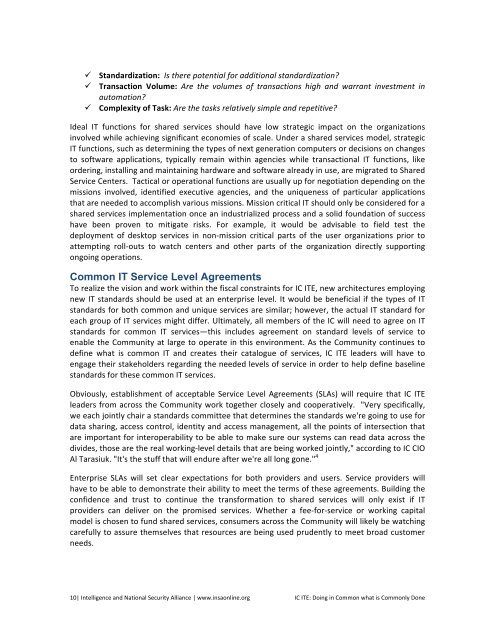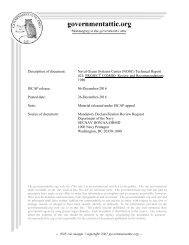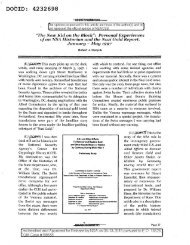insa-ic-ite
insa-ic-ite
insa-ic-ite
You also want an ePaper? Increase the reach of your titles
YUMPU automatically turns print PDFs into web optimized ePapers that Google loves.
ü Standardization: Is there potential for additional standardization? <br />
ü Transaction Volume: Are the volumes of transactions high and warrant investment in <br />
automation? <br />
ü Complexity of Task: Are the tasks relatively simple and repetitive? <br />
Ideal IT functions for shared serv<strong>ic</strong>es should have low strateg<strong>ic</strong> impact on the organizations <br />
involved while achieving signif<strong>ic</strong>ant economies of scale. Under a shared serv<strong>ic</strong>es model, strateg<strong>ic</strong> <br />
IT functions, such as determining the types of next generation computers or decisions on changes <br />
to software appl<strong>ic</strong>ations, typ<strong>ic</strong>ally remain within agencies while transactional IT functions, like <br />
ordering, installing and maintaining hardware and software already in use, are migrated to Shared <br />
Serv<strong>ic</strong>e Centers. Tact<strong>ic</strong>al or operational functions are usually up for negotiation depending on the <br />
missions involved, identified executive agencies, and the uniqueness of part<strong>ic</strong>ular appl<strong>ic</strong>ations <br />
that are needed to accomplish various missions. Mission crit<strong>ic</strong>al IT should only be considered for a <br />
shared serv<strong>ic</strong>es implementation once an industrialized process and a solid foundation of success <br />
have been proven to mitigate risks. For example, it would be advisable to field test the <br />
deployment of desktop serv<strong>ic</strong>es in non-‐mission crit<strong>ic</strong>al parts of the user organizations prior to <br />
attempting roll-‐outs to watch centers and other parts of the organization directly supporting <br />
ongoing operations. <br />
Common IT Serv<strong>ic</strong>e Level Agreements<br />
To realize the vision and work within the fiscal constraints for IC ITE, new arch<strong>ite</strong>ctures employing <br />
new IT standards should be used at an enterprise level. It would be benef<strong>ic</strong>ial if the types of IT <br />
standards for both common and unique serv<strong>ic</strong>es are similar; however, the actual IT standard for <br />
each group of IT serv<strong>ic</strong>es might differ. Ultimately, all members of the IC will need to agree on IT <br />
standards for common IT serv<strong>ic</strong>es—this includes agreement on standard levels of serv<strong>ic</strong>e to <br />
enable the Community at large to operate in this environment. As the Community continues to <br />
define what is common IT and creates their catalogue of serv<strong>ic</strong>es, IC ITE leaders will have to <br />
engage their stakeholders regarding the needed levels of serv<strong>ic</strong>e in order to help define baseline <br />
standards for these common IT serv<strong>ic</strong>es. <br />
Obviously, establishment of acceptable Serv<strong>ic</strong>e Level Agreements (SLAs) will require that IC ITE <br />
leaders from across the Community work together closely and cooperatively. "Very specif<strong>ic</strong>ally, <br />
we each jointly chair a standards committee that determines the standards we're going to use for <br />
data sharing, access control, identity and access management, all the points of intersection that <br />
are important for interoperability to be able to make sure our systems can read data across the <br />
divides, those are the real working-‐level details that are being worked jointly," according to IC CIO <br />
Al Tarasiuk. "It's the stuff that will endure after we're all long gone." 4<br />
Enterprise SLAs will set clear expectations for both providers and users. Serv<strong>ic</strong>e providers will <br />
have to be able to demonstrate their ability to meet the terms of these agreements. Building the <br />
confidence and trust to continue the transformation to shared serv<strong>ic</strong>es will only exist if IT <br />
providers can deliver on the promised serv<strong>ic</strong>es. Whether a fee-‐for-‐serv<strong>ic</strong>e or working capital <br />
model is chosen to fund shared serv<strong>ic</strong>es, consumers across the Community will likely be watching <br />
carefully to assure themselves that resources are being used prudently to meet broad customer <br />
needs. <br />
10| Intelligence and National Security Alliance | www.<strong>insa</strong>online.org IC ITE: Doing in Common what is Commonly Done
















